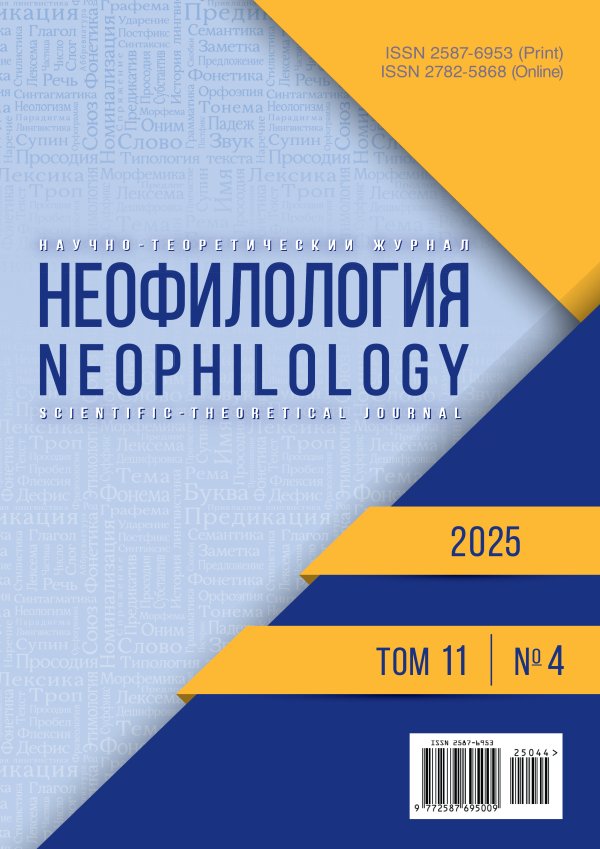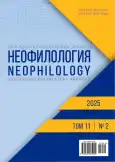Языковые особенности молодёжной интернет-коммуникации
- Авторы: Сергеева А.М.1, Моисеева Л.С.2
-
Учреждения:
- МБУ «Централизованная библиотечная система»
- ФГБОУ ВО «Тамбовский государственный университет им. Г.Р. Державина»
- Выпуск: Том 11, № 2 (2025)
- Страницы: 273-282
- Раздел: ПАРАДИГМЫ ЯЗЫКОЗНАНИЯ И СОВРЕМЕННАЯ ЛИНГВИСТИКА
- URL: https://journal-vniispk.ru/2587-6953/article/view/297432
- DOI: https://doi.org/10.20310/2587-6953-2025-11-2-273-282
- ID: 297432
Цитировать
Полный текст
Аннотация
ВВЕДЕНИЕ. В настоящее время интернет-коммуникация является уникальной средой, в которой отражаются языковые особенности молодёжного общения, отличающиеся от традиционного способа общения. Целью исследования является анализ языковых средств, используемых в молодёжной интернет-коммуникации. Изменения в языковых особенностях интернет-коммуникации в настоящее время сопряжены не только с использованием молодёжного жаргона и сленга, аббревиатур и сокращений, но и различных графических изображений, отражающих эмоциональный настрой высказываний.
МАТЕРИАЛЫ И МЕТОДЫ. Материалом исследования послужили тексты переписки молодых коммуникантов в сети Интернет, в мессенджерах «Телеграм», «ВКонтакте». Исследование эмпирического материала проведено на основе описательного и сравнительного методов, использовался метод сплошной выборки текстовых единиц и метод лингвистического анализа, направленный на выявление системы языковых средств для определения словесных конструкций и языковых единиц.
РЕЗУЛЬТАТЫ ИССЛЕДОВАНИЯ. Выявлены специфические лексические средства (лексемы молодёжного компьютерного сленга), сокращения, эмодзи и эмотикон, служащие для передачи эмоционального содержания сообщений в молодёжной интернеткоммуникации. Доказано, что любые изменения в молодёжной интернет-коммуникации необходимо фиксировать, чтобы ориентировать молодых людей на кодифицированное использование русского языка.
ЗАКЛЮЧЕНИЕ. Установлено, что молодёжное общение в интернет-среде, отличающееся от традиционной формы коммуникации, проявляется в грамматике и орфографии русского языка, в развитии явлений парцелляции и сокращения, в проникновении интернет-сленга в живое повседневное общение. Результаты могут быть использованы в рамках филологического и лингвистического анализа текста, при изучении языка Интернета и интернет-стиля.
Ключевые слова
Об авторах
А. М. Сергеева
МБУ «Централизованная библиотечная система»
Email: SergeevaAnastasia3256@yandex.ru
ORCID iD: 0009-0001-0434-7496
библиотекарь
Россия, 393250, Российская Федерация, Тамбовская обл., г. Рассказово, ул. Пушкина, 12Л. С. Моисеева
ФГБОУ ВО «Тамбовский государственный университет им. Г.Р. Державина»
Автор, ответственный за переписку.
Email: Moiseeva-LS@mail.ru
ORCID iD: 0009-0004-1391-1249
кандидат филологических наук, доцент кафедры историко-филологического образования
Россия, 392000, Российская Федерация, г. Тамбов, ул. Интернациональная, 33Список литературы
- Мигунова Ю.В. Особенности влияния виртуального пространства на современную молодёжь // Теория и практика общественного развития. 2021. № 11. С. 51-55. https://doi.org/10.24158/tipor.2021.11.6, https://elibrary.ru/lrbemc
- Ганеева Л.В. Средства речевого воздействия в современной интернет-коммуникации (на примере соци-альной сети «ВКонтакте») // Мир науки, культуры, образования. 2023. № 5 (102). С. 326-328. https://doi.org/10.24412/1991-5497-2023-5102-326-328, https://elibrary.ru/xwmygf
- Potapova R.K. Stylistic features of Russian-language Internet communication of the younger generation // Vest-nik of Moscow State Linguistic University. Humanities. 2023. № 7 (875). P. 101-111. https://doi.org/10.52070/2542-2197_2023_7_875_101, https://elibrary.ru/klnryg
- Andreeva E.Yu. Problems of verbal and non-verbal communication of multinational students on the Internet // Mir Nauki, Kultury, Obrazovaniya. 2024. № 3 (106). P. 492-494. https://doi.org/10.24412/1991-5497-2024-3106-492-494, https://elibrary.ru/pvpfzb
- Buryak N.Yu. The impact of Internet communications on the Russian language and culture of speech // Interna-tional Journal of Humanities and Natural Sciences. 2021. № 11-1 (62). P. 31-33. https://doi.org/10.24412/2500-1000-2021-11-1-31-33, https://elibrary.ru/dfoqcm
- Несина В.В. Тенденции развития интернет-коммуникации в современной России // Гуманитарный науч-ный вестник. 2023. № 5. С. 11-14. https://doi.org/10.5281/zenodo.8033503, https://elibrary.ru/uyfdls
- Балян С.Н. Семиотика эмодзи // Социально-гуманитарные проблемы образования и профессиональной самореализации (Социальный инженер-2023): сб. материалов Междунар. науч. конф. молодых исследо-вателей. Москва: Рос. гос. ун-т им. А.Н. Косыгина, 2023. С. 184-189. https://elibrary.ru/fbbbjb
- Лю Ц. Эмодзи как средство проявления речевой агрессии в интернет-коммуникации (на материале рус-ского и китайского языков) // Вестник Московского государственного лингвистического университета. Гуманитарные науки. 2023. № 2 (870). С. 66-70. https://doi.org/10.52070/2542-2197_2023_2_870_66, https://elibrary.ru/frjoog
- Шутова Л.С. Функционирование эмодзи в электронной коммуникации // Иностранные языки и совре-менные тенденции в иноязычном образовании: материалы 8 Всерос. науч.-практ. конф., посвящ. 100-летию со дня рождения д-ра филол. н., профессора ВГПУ Сергея Самуиловича Беркнера. Воронеж: ВГПУ, 2024. С. 178-184. https://elibrary.ru/dwodeo
- Nenasheva Y.A. Emoji – means of sharing “common knowledge” about emotions and their intonation in dis-course // Russian Linguistic Bulletin. 2023. № 1 (37). https://doi.org/10.18454/RULB.2023.37.15, https://elibrary.ru/ovliqg
- Воякина Е.Ю. Визуализация современной цифровой коммуникации: эмодзи вместо слов // Преподаватель XXI век. 2023. № 2-2. С. 392-404. https://doi.org/10.31862/2073-9613-2023-2-392-404, https://elibrary.ru/hhrwze
- Холод А.Л. Понятие интернет-коммуникаций // Карповские научные чтения: сб. науч. ст. Вып. 11. Минск: ИВЦ Минфина, 2017. Ч. 1. С. 298-302. https://elib.bsu.by/handle/123456789/179884
- Виноградова Т. Ю. Специфика общения в Интернете // Русская и сопоставительная филология: лингво-культурологический аспект. Казань: Казан. (Приволж.) фед. ун-т, 2004. С. 63-67. https://elibrary.ru/vlvayh
- Шаповалова И.С. Влияние интернет-коммуникаций на поведение и интеллектуальное развитие молоде-жи // Социологические исследования. 2016. № 4 (372). С. 148-151. https://elibrary.ru/trrqpz
- Гуреева А.Н. Трансформация медиакоммуникационного взаимодействия государства и молодежи в Рос-сии в контексте медиатизации политики // Вестник Московского университета. Серия 10. Журналистика. 2020. № 6. С. 160-181. https://doi.org/10.30547/vestnik.journ.6.2020.160181, https://elibrary.ru/mfwjsq
- Бабук А.В. Эмотиконы и эмодзи в интернет-коммуникации // Журналистика – медиалогия – наставниче-ство: материалы Междунар. науч.-практ. конф., посвящ. памяти проф. Б.В. Стрельцова. Минск: Белорус. гос. ун-т, 2023. С. 13-17. https://elibrary.ru/welqhy
- Кашин В.В. Чарльз Пирс о репрезентирующей функции знака // Вестник Оренбургского государственно-го университета. 2010. № 7 (113). С. 127-132. https://elibrary.ru/mssfbf
- Исрафилова А.Х., Котельникова Н.П. Сленг в речи современного подростка // Юный учёный. 2017. № 1 (10). С. 1-3. https://elibrary.ru/ygkjhx
- Горшукова К.М. Сленг в речи современной русскоязычной молодежи // Семиотика волонтерства как со-циокультурный феномен: материалы межвуз. науч.-практ. конф. Краснодар: Кубан. гос. аграрный ун-т им. И.Т. Трубилина, 2019. С. 126-128. https://elibrary.ru/vmeqfr
- Голошубина О.К. Разговор в мессенджере как специфический жанр интернет-коммуникации // Вестник Омского университета. 2015. № 1 (75). С. 208-212. https://elibrary.ru/tqirvn
Дополнительные файлы











